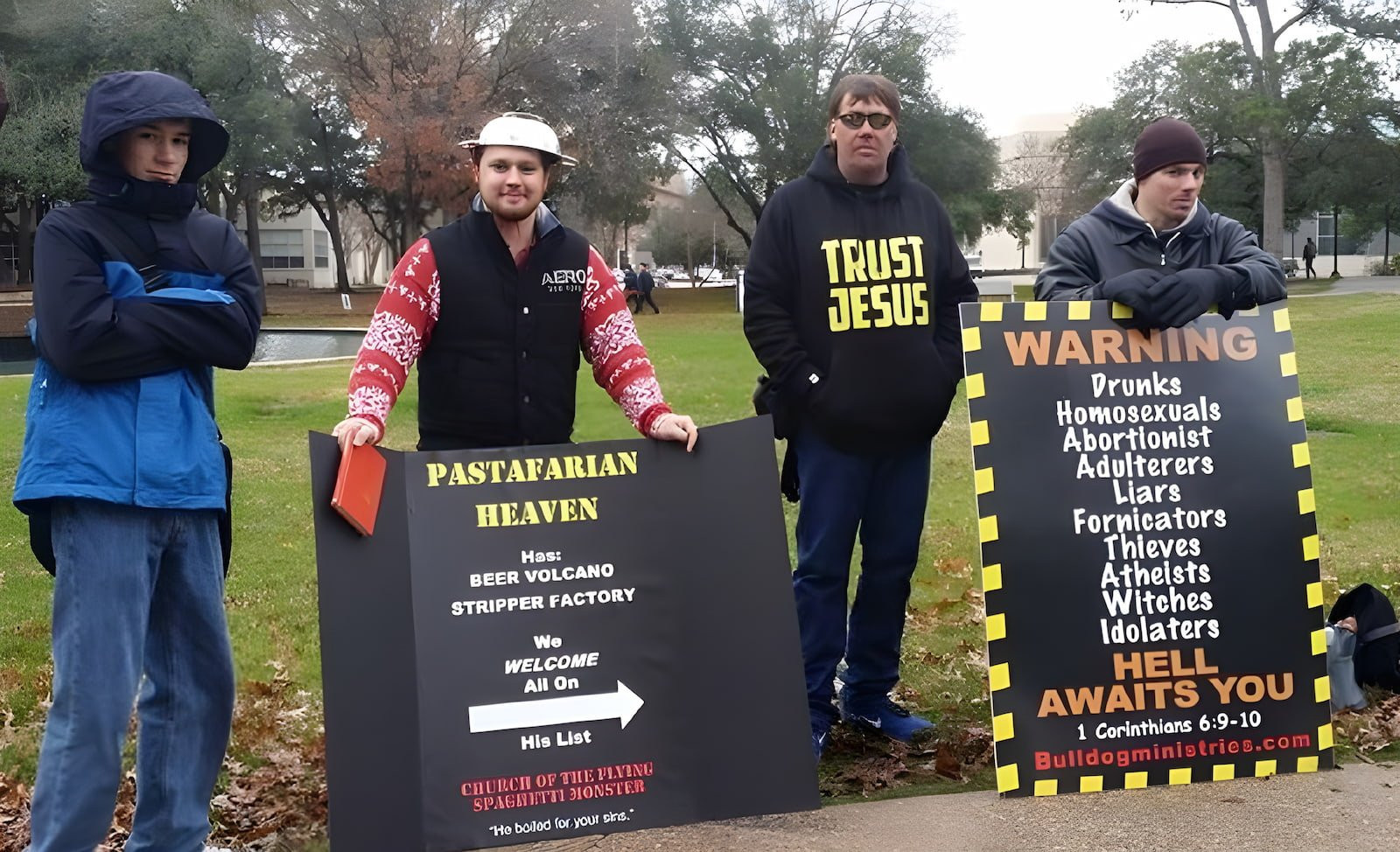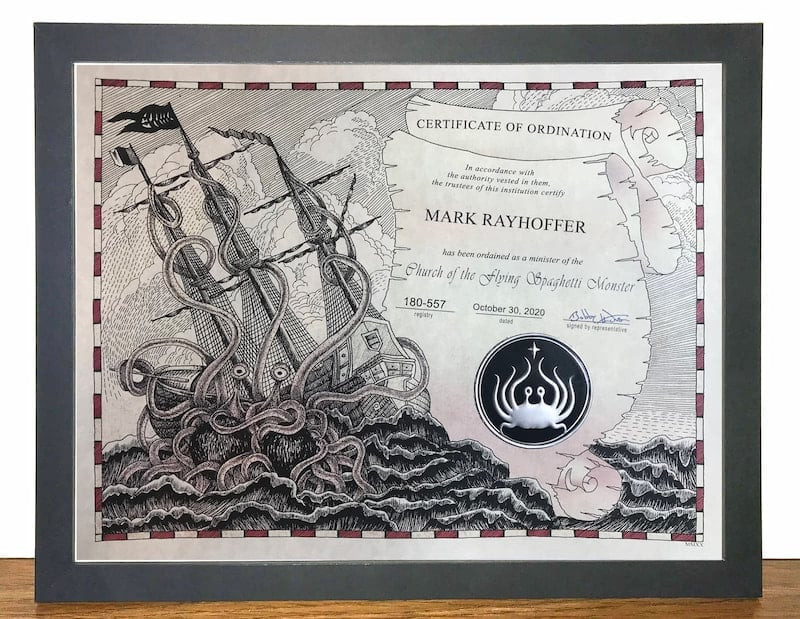The Church of the Flying Spaghetti Monster, often abbreviated as FSM, burst into the public consciousness relatively recently, despite some playful claims of centuries-long secrecy. This unique and often humorous religion has garnered millions of followers, or perhaps “worshippers” in the loosest sense, and is widely recognized as a legitimate religious movement, even by those who might disagree with its tenets. But behind the playful facade and satirical elements, a crucial question arises: who made the Flying Spaghetti Monster? Understanding the origin of this deity is key to grasping the essence of Pastafarianism itself.
The Genesis of the FSM: A Provoked Creation
To understand who “made” the Flying Spaghetti Monster, it’s essential to understand why it was made. The birth of the FSM wasn’t a spontaneous spiritual awakening, but rather a direct response to a specific event: the promotion of Intelligent Design in public schools. In 2005, the Kansas State Board of Education was considering incorporating Intelligent Design into its science curriculum, suggesting it as an alternative theory to evolution.
This move sparked controversy, as many scientists and educators argued that Intelligent Design is not a scientific theory but a religious viewpoint, essentially a form of creationism. Enter Bobby Henderson, a physics graduate from Oregon State University. In a stroke of satirical genius, Henderson penned an open letter to the Kansas State Board of Education. This letter, which became the foundational document of Pastafarianism, is where the Flying Spaghetti Monster was officially “born.”
Henderson’s letter wasn’t a serious proposition to replace Intelligent Design with another deity. Instead, it was a brilliant reductio ad absurdum argument. He argued that if Intelligent Design, a concept lacking scientific evidence, was to be given equal time in science classrooms, then so too should Pastafarianism. He posited the Flying Spaghetti Monster as the creator of the universe, complete with equally (and intentionally) absurd “evidence.”
The core of Henderson’s satirical argument was this: if the criteria for teaching a theory in science class is simply that it offers an alternative to evolution and invokes a creator, then the Flying Spaghetti Monster theory is just as valid as Intelligent Design. Both lack empirical scientific backing and rely on faith-based explanations. By creating the Flying Spaghetti Monster, Henderson cleverly highlighted the non-scientific nature of Intelligent Design and the absurdity of teaching it as science.
Bobby Henderson: The Prophet (and Physicist) Behind the Pasta
So, in answer to the question “who made the Flying Spaghetti Monster,” the most direct answer is Bobby Henderson. He is the originator of the open letter, the conceptualizer of the FSM deity, and the de facto “prophet” of Pastafarianism. While Pastafarianism is presented as a religion, it’s crucial to understand that Henderson’s intention was not to found a new faith in the traditional sense.
Henderson, with his background in physics, understood the principles of scientific inquiry and the importance of evidence-based reasoning. His creation of the Flying Spaghetti Monster was a strategic and satirical move to defend science education and critical thinking against what he saw as the encroachment of pseudoscience disguised as religion.
It’s important to note that Henderson doesn’t present himself as a divine figure or claim any supernatural authority. Instead, he embodies the spirit of Pastafarianism – questioning, humorous, and grounded in rationality. His “expertise” isn’t in theology, but in physics and satire, making him uniquely qualified to create a religion designed to challenge unscientific claims.
From Open Letter to Global Phenomenon: The Rise of Pastafarianism
The open letter was not just a clever argument; it was incredibly effective in capturing public attention. It went viral, spreading rapidly across the internet in 2005. The absurdity of the Flying Spaghetti Monster, coupled with the sharp critique of Intelligent Design, resonated with many people, particularly those in the scientific and skeptical communities.
People began to identify with Pastafarianism, not necessarily as a literal religion, but as a symbol of reason, satire, and the separation of church and state. The Church of the Flying Spaghetti Monster grew organically, fueled by online communities and a shared understanding of its satirical purpose. It became a way for people to express their skepticism towards dogma and pseudoscience while engaging in lighthearted community and parody.
The FSM’s popularity highlights the power of satire and humor in addressing serious issues. What started as a pointed critique of educational policy evolved into a global phenomenon, demonstrating the broad appeal of its message of rational thought and the rejection of unfounded claims, all wrapped in a noodly, pirate-themed package.
Core Tenets of Pastafarianism (Briefly, as Background)
While Bobby Henderson “made” the Flying Spaghetti Monster, the religion itself has developed a set of tongue-in-cheek beliefs and traditions that further its satirical goals. These include:
- The Flying Spaghetti Monster as Creator: The FSM is believed to be the creator of the universe, albeit in a way that intentionally mirrors and parodies creationist narratives.
- Pirates as Original Pastafarians: Pastafarianism reveres pirates as peaceful explorers, whose image was unfairly tarnished by Christian misinformation. This is a humorous counterpoint to negative stereotypes and historical revisionism.
- Heaven with Beer Volcano and Stripper Factory: The Pastafarian afterlife is envisioned as a heaven with a beer volcano and stripper factory, a deliberately hedonistic and absurd contrast to more traditional religious heavens.
- Rejection of Dogmatism: A core tenet is the rejection of dogmatism and literal interpretations, even of Pastafarian scripture. This encourages critical thinking and open-mindedness.
These beliefs, while humorous, serve to underscore the satirical nature of Pastafarianism and its critique of literalism and unsubstantiated religious claims.
Is Pastafarianism a Real Religion? And Does it Matter?
The question of whether Pastafarianism is a “real” religion is often debated, and intentionally blurred by Pastafarians themselves. In a legal and sociological sense, it has been recognized as a religion in some contexts, granting certain rights and recognitions. However, for many Pastafarians, the label of “religion” is itself part of the satire.
What truly matters is not the label, but the values and community that Pastafarianism fosters. It provides a space for skepticism, critical thinking, and community, often for people who feel alienated by more dogmatic or literalist religions. As the original article notes, “you do not have to Believe to be part of our Church,” emphasizing the inclusive and non-dogmatic nature of Pastafarianism. It’s a religion that doesn’t demand blind faith, but rather encourages questioning and rational thought.
 Pastafarian ministers on campus
Pastafarian ministers on campus
Becoming a Pastafarian: Embracing the Noodly Path
Joining the Church of the Flying Spaghetti Monster is intentionally simple and non-exclusive. There is no formal membership process, no required dogma, and no financial obligations. As the official website states, “Please consider yourself a member.” This open and welcoming approach reflects the inclusive spirit of Pastafarianism.
For those who wish to support the Church more formally, ordination certificates are available for purchase. Becoming a minister in the Church of the Flying Spaghetti Monster is a symbolic act, often embraced by those who want to further spread the word and participate more actively in the community.
 Pastafarian ordination certificate
Pastafarian ordination certificate
Spreading the Word: Evangelism, Pastafarian Style
Evangelism in Pastafarianism takes a decidedly humorous and unconventional form, mirroring the satirical nature of the religion itself. Instead of proselytizing through sermons and dogma, Pastafarians spread the word through creative and often outlandish displays, such as:
- Parades and Floats: Participating in parades with Flying Spaghetti Monster themed floats, often incorporating pirate costumes and imagery.
- Holiday Tree Toppers: Creating FSM-themed tree toppers for holiday decorations, subverting traditional religious symbols with a noodly twist.
- Colander Headwear: Wearing colanders as religious headwear, often in situations where religious expression is debated, such as driver’s license photos or workplaces.
 Pastafarian tree topper
Pastafarian tree topper
These acts of “evangelism” are not about forceful conversion, but about raising awareness, sparking conversations, and injecting humor into discussions about religion and society. They embody the Pastafarian spirit of lightheartedness, satire, and challenging conventional norms.
Conclusion:
The Flying Spaghetti Monster was “made” by Bobby Henderson as a satirical tool to challenge the inclusion of Intelligent Design in science education. However, this noodly creation has grown far beyond its initial purpose, evolving into a global phenomenon that embodies skepticism, community, and the power of satire. Understanding who made the Flying Spaghetti Monster reveals the origins of a unique and thought-provoking movement that continues to playfully question dogma and encourage rational thought in a world often dominated by unquestioned beliefs. Whether viewed as a religion, a parody, or a philosophy, Pastafarianism and its Flying Spaghetti Monster have undoubtedly made a lasting and impactful mark on contemporary culture.